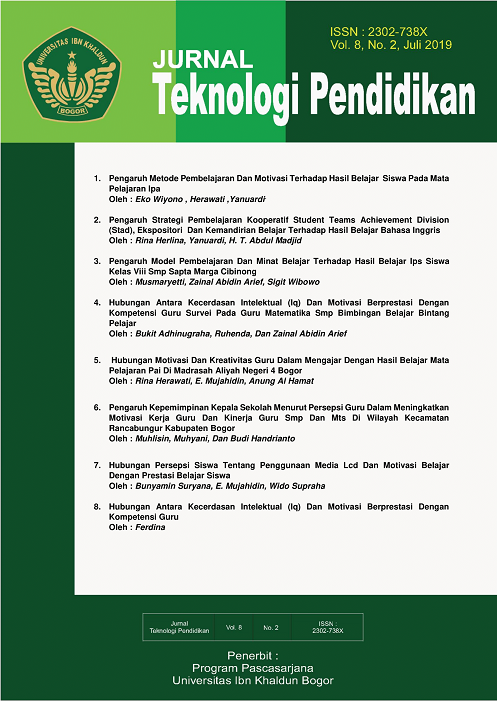GAMBARAN RESILIENSI AKADEMIK SISWA SMK DI MASA PANDEMI COVID-19
DOI:
https://doi.org/10.32832/tek.pend.v11i2.6651Keywords:
Academic Resilience, Covid-19 and Online LearningAbstract
Abstract: This writing aim to discover the level of academic resilience of vocational students. The policy of online learning during the COVID-19 pandemic raises various challenges in all aspects of education, especially for students. The proper response to survive in pandemic conditions is needed by students to maintain the stabilization of the learning process. The researcher used a quantitative descriptive method with a sample of 220 vocational students from four majors selected using a simple random sampling technique. This study used the Academic Resilience Scale (ARS). The data analysis process is based on categorizing the maximum, minimum, mean, and standard deviation of academic resilience. The results of the categorization show that there are more students in the medium and high scores. It shows that vocational students during the pandemic have good academic resilience abilities, but the emotional ability score is low, and intervention is need.
References
Aburn, G., Gott, M., & Hoare, K. (2016). What is resilience? An integrative review of the empirical literature. Journal of Advanced Nursing, 72(5), 980–1000.
Ade; Samsul; Dinda., (2020). Gambaran resiliensi akademik mahasiswa pada masa pandemi covid-19. J. Pendidik. Dan Konseling, 10(2): 240–246 http://jurnal.uinsu.ac.id/index.php/al-irsyad.
Alva, S. A. (1991). Academic invulnerability among Mexican-American students: The importance of protective resources and appraisals. Hispanic Journal of Behavioral Sciences, 13(1), 18-34.
Alva, S. A. (1991). Academic invulnerability among Mexican-American students: The importance of protective resources and appraisals. Hispanic Journal of Behavioral Sciences, 13(1), 18-34.
Bernard, B. (2007). The foundations of the resiliency paradigm. In N. Henderson, (Ed.) Resliency in action: Practical ideas for overcoming risks and building strengths in youth, families and communities (pp. 3-7). Ojai, CA: Resiliency in Action.
Cassidy, S. (2016). The Academic Resilience Scale (ARS-30): A new multidimensional construct measure. Frontiers in Psychology, 7(Nov), 1–11. https://doi.org/10.3389/fpsyg.2016.0178 7
Christine, D. B. (2010). A review of the literature resiliency skills and dropout prevention. ScholarCentric.com.
Daniel, S. J. (2020). Education And The COVID-19 Pandemic. Prospects, 0123456789. https://doi.org/10.1007/s11125-020-09464-3
Finn, J. D., & Rock, D. A. (1997). Academic success among students at risk for school failure. Journal of Applied Psychology, 82(2), 221-34.
Fitri dan Kushendar. 2019. Konseling Kelompok Cognitive Rectructuring untuk Meningkatkan Resiliensi Akademik Mahasiswa. Jurnal Bulletin of Counseling and Psychotherapy. (01) 2:67.
Groves, Robert M., (2010). Survey Methodology. Second edition of the (2004) first edition ISBN 0-471-48348-6
Hardy, S.E., Concato, J., Gill, T.M., (2004). Resilience of Community-Dwelling Older Persons. New York: Mc Graw Hill
Hendriani, W. 2017. Adaptasi Positif Pada Resiliensi Akademik Mahasiswa Doktoral. Jurnal Humanitas. (14) 02: 139-149.
Howard, S., & Johnson, B. (2000). What Makes the Difference? Children and teachers talk about resilient outcomes for children "at risk.” Educational Studies, 26(3), 321–337. https://doi.org/10.1080/03055690050137132
Kementian Pendidikan Dan Kebudayaan (2020)Analisis Survei Cepat Pembelajaran Dari Rumah Dalam Masa Pencegahan COVID-19.http://repositori.kemdik bud.go.id/22 366/1/1_ Hasil_Survey_ Cepat_BDR-Kepala_ Sekolah_dan_Guru_%281%29.pdf
Kompetensi Inti dan Kompetensi dasar SMK/MAK Perhotelan.file:///C:/Users/hp/Downloads/8_1_2_KIKD_ Perhotelan_COMPILED.pdf
Kompetensi Inti dan Kompetensi dasar SMK/MAK Rekayasa Perangkat lunak file:///C:/Users/hp/Downloads /3_1_1_KIKD_Rekayasa_Perangkat_Lunak_COMPILED.pdf
Kumalasari, D.; Akmal, S.Z., (2020). Resiliensi akademik dan kepuasan belajar daring di masa pandemi COVID-19: Peran mediasi kesiapan belajar daring. Pers. Psikol. Indones., 9(2): 353–368.
Ledesma, J. (2014). Conceptual frameworks and research models on resilience in leadership. Sage Open, 4(3), 2158244014545464. https://doi.org/10.1177/2158244014545464
Lee, P.-I & Hsueh, P.-R. 2020. Emerging threats from zoonotic coronaviruses-from SARS and MERS to 2019-nCoV. Journal of Microbiology, Immunology and Infection.
Martin, A. (2002). Motivation and academic resilience: Developing a model for student enhancement. Australian Journal of Education, 46(1), 34–49. https://doi.org/10.1177/000494410204600104
Martin, A. J., & Marsh, H. W. (2009). Academic resilience and academic buoyancy: Multidimensional and hierarchical conceptual framing of causes, correlates and cognate constructs. Oxford Review of Education, 35(3), 353–370. https://doi.org/10.1080/03054980902934639
Masten, A. S., Best, K. M., & Garmezy, N. (1990). Resilience development: Contributions from the study of children who overcome adversity. Development and Psychopathology, 2(2), 425-444.
Pedoman penyelengaraan uji kompetensi Keahlian SMK Tahun 2020-2021. https://smk.kemdikbud.go.id/poe = web secara umum
Poerwanto, A.; Prihastiwi, W.J., (2017). ANALISIS PREDIKTOR RESILIENSI AKADEMIK SISWA SEKOLAH MENENGAH PERTAMA di KOTA SURABAYA. Psikosains, 12(1): 45–57 http://ir.obihiro.ac.jp/dspace/handle/10322/3933.
Purwanto, A. et al (2020). Studi Eksploratif Dampak Pandemi Covid 19 terhadap Pembelajaran Online di Sekolah Dasar. Journal of Education, Psychology and Counseling, 2(1), 1-12
Rahmanisa, R.; Rahmat, H.K.; Cahaya, I., (2021).Mengembangkan Resiliensi Individu di Tengah Masa Pandemi COVID-19 Menggunakan Islamic Art Therapy [Strategy to Develop Individual Resilience in The Middle J. 1(1): 39–52 http://alisyraq.pabki.org/index.php/jcic/article/view/60.
Sari, S.P.; Aryansah, J.E.; Sari, K., (2020). Resiliensi mahasiswa dalam menghadapi pandemic covid 19 dan implikasinya terhadap proses pembelajaran. Indones. J. Guid. Couns. Theory Appl., 9(1): 17–22 journal.unnes.ac.id/sju/index.php/jbk.
Scales, P. C., Benson, P. L., Roehlkepartain, E. C., Sesma, A., & van Dulmen, M. (2006). The role of developmental assets in predicting academic achievement: A longitudinal study. Journal of Adolescence, 29(5), 691–708. https://doi.org /10.1016/j .adolescence .2005.09.001
Smith, G. (1999). Resilience concepts and findings: implications for family therapy. Journal of Family Therapy, 21, 154-158
Smokowski, P. R., Reynolds, A. J., & Bezruczko, N. (1999). Resilience and protective factors in adolescence: An autobiographical perspective from disadvantaged youth. Journal of School Psychology, 37(4), 425-48.
Statistik Data Anak Putus Sekolah Pada Siswa SMK. http:// statistik. data.kemdikbud .go.id/index.php/page/smk. Diakses 15 Juli 2021
Sugiyono, (2019). Metode Penelitian Kuantitatif Kualitatif dan R&D. Alfabeta: Bandung
Taylor, E. R. (2000). Making Resiliency Meaningful in the New Millennium. Retrieved from http://www. meaning.ca/pdf/2000proceedings elizabeth_ taylor.
Utami, L.H., (2020). Bersyukur dan Resiliensi Akademik Mahasiswa. Nathiqiyyah J. Psikol. Islam, 3(1): 1–21 https://ojs.diniyah.ac.id/index.php/Nathiqiyyah/article/view/69.
Wang, M. C., & Gordon, E. W. (1994). Educational resilience in inner city America. Hillsdale, NJ, Erlbaum
Wang, M. C., & Gordon, E. W. (1994). Educational resilience in inner city America. Hillsdale, NJ, Erlbaum
Wibowo, Ucha Febrianchi. (2018) Resiliensi Akademik Mahasiswa yang sedang Menempuh Skripsi. Skripsi. Universitas Muhammadiyah Malang
Willda, T., Nazriati, E., & Firdaus. (2016). Hubungan Resiliensi Diri Terhadap Tingkat Stres pada Dokter Muda Fakultas Kedokteran Universitas Riau. Jom FK, 3(1), 1–9.
Wolin, S. J., & Wolin, S. (1993). The resilient self: How survivors of troubled families rise above adversity. New York: Villard Books.
Downloads
Published
How to Cite
Issue
Section
License



















